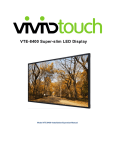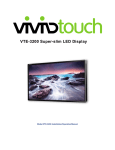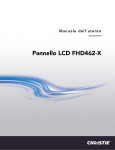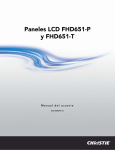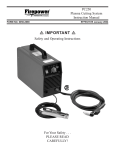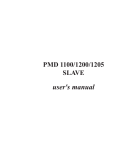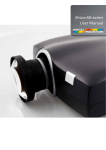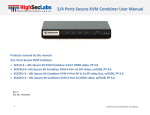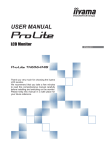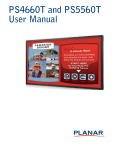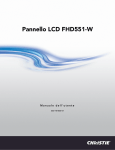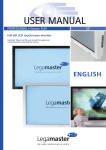Download VTS-6500 - User Manual
Transcript
VTS-8510 Super-slim UHD LED Display Model VTS-8510 Installation/Operation Manual COPYRIGHT AND TRADEMARKS: © Copyright 2015. This document contains proprietary information protected by copyright, trademark and other intellectual property laws. All rights are reserved. No part of this manual may be reproduced by any mechanical, electronic or other means, in any form, without our prior written permission. The trademarks reproduced in this document and used on the products are either owned or licensed by us, or by their respective holders. You may not reproduce or use the trademarks without our prior written consent. 2 Important Safety Instructions • Before using this display, please read this user manual thoroughly to help protect against property damage and to ensure your personal safety and the safety of others. • Be sure to observe the following instructions. • For your safety, be sure to observe the warnings located in this manual. • For installation or adjustment, please follow the instructions in this manual and refer all servicing to qualified service personnel. Safety Precautions • If smoke or a peculiar smell comes from the display, remove the power plug from the outlet immediately. • Failure to do so may result in fire or electrical shock. Contact your dealer for inspection. • If the display has been turned on but there isn’t a picture, remove the power plug from the outlet immediately. • Failure to do so may result in fire or electrical shock. Contact your dealer for inspection. • If water is spilled or objects are dropped inside the display, remove the power plug from the outlet immediately. • Failure to do so may result in fire or electrical shock. Contact your dealer for inspection. • If the display is dropped or the cabinet is damaged, remove the power plug from the outlet immediately. • Failure to do so may result in fire or electrical shock. Contact your dealer for inspection. • To turn off the power of the display, press “O” on the main power switch at side of display. • The power standby/on indicator will go off and the display cannot to be turned on/off by using the POWER button on the remote control. (To turn on/off the display by the remote control, press the main power switch again and light the power standby/on indicator.) When turning off the display by pressing the POWER button on the remote control, the main power of the display is not turned off completely. To disconnect power completely, remove the power plug from the outlet. • If the power cord or plug is damaged or becomes hot, turn off the main power switch of the display, make sure the power plug has cooled down and remove the power plug from the outlet. • If the display is still used in this condition, it may cause fire or electrical shock. Contact your dealer for replacement. Installation • Don't install in a high-temperature environment. • If the display is used in high-temperature or in direct sunlight, it may cause the case or other parts to become distorted or damaged, resulting in overheating or electrical shock. • Don't install in a high-humidity environment. • This may cause overheating or electrical shock. • Don't install near any heat sources such as radiators, heat registers, stoves, or other apparatus that produce heat. • This may cause fire or electrical shock. • Don't overload outlets or cables beyond electrical capacity. • Don't use extension cords as it may cause fire or electrical shock. 3 • Don't insert the power plug into an outlet other than 100~240V AC. • This may cause fire or electrical shock. Don’t use a damaged power plug or worn outlet. Don’t insert an improper power plug it may cause fire or electric shock. • Don't place the display on an unstable shelf or surface. • The display may fall, causing injury. Please install on a horizontal, stable, level surface. • Don't place objects on the display. • If the display is covered or the vents are blocked, the display could overheat and cause a fire. If metal or liquid gets into the display, it may cause fire or electrical shock. Do not put heavy objects on the display as they may fall, causing injury. Please keep a 10 cm minimum distance between the display and the wall for sufficient ventilation. Don't move the display when it is connected to the power cord and AV cables. When moving the display, make sure to remove the power plug and cables from the outlet or source. When unpacking or carrying the display, at least 2 people are needed. Make sure the display is carried upright. Transport the display upright. Avoid placing the display face up or down. Handle the display gently. Do not drop. Use • If you encounter a problem during installation, please contact your dealer for assistance. Don’t repair or open the display by yourself. • Failure to do so may result in fire or electrical shock. Contact your dealer for inspection. • Protect and correctly use the power cord/plug. Don't pinch the power cord/plug between hard surfaces. Don't step on the power cord/plug. Before inserting the power plug into the wall outlet, connect the power cord to the display. Don't operate the display with a damaged power cord or it may damage the display. • Using extension cords (not recommended) • If an extension cord must be used, ensure the voltage rating exceeds the max power consumption of the display. If the voltage rating is less than the display, it will cause the extension cord to overheat. • If there is thunder or lightning, don’t touch the display or the power plug. • This may cause an electric shock. • Don’t use any kind of liquid on the display. If liquid is spilled on the display, remove the power and ask qualified service personnel to check the display. If the liquid gets on the display’s screen, please clean it with a dry and soft cloth immediately. Don’t use any harsh chemical on the display. If metal or liquid gets into the display, it may cause a fire or an electrical shock. 4 • Don’t install or remove the power plug with wet hands. • This may cause an electrical shock. • If the display will not be used for a long period of time, unplug the display. • This may cause premature wear of electrical components or fire. • Don’t press on the LCD panel. • This may cause personal injury or panel damage. • Don't push or shake the display. • This may cause damage or injury. If the glass of the display panel is broken, liquid may escape. Please don't touch the liquid. If liquid get into your eyes or touches your skin, wash with the clean water and seek medical attention immediately. Precautions with the remote control batteries Please only use approved AAA type batteries. Please be sure to insert batteries by matching the + and -. Don’t recharge, heat, disassemble, short or throw batteries into a fire. Don’t mix a new battery with a used one. Don’t mix different types of batteries together (only use the specified type). it may cause burn and injury. Cleaning • If dust has collected on the power plug, removed the plug from the outlet and clean off the dust. • Dust build-up may cause a fire. • Take off the power plug before cleaning. • Failure to do so may result in electrical shock or damage. • Cleaning the surface of the display When the surface of the display becomes dirty, please wipe the surface lightly with a soft clean cloth. If the surface requires additional cleaning, lightly moisten the cloth. Do not to let any kind of liquid enter the display as it may cause electrical shock or damage. Do not clean the display with alcohol, solvents or ammonia, as this could damage the display. 5 Warnings Use • Do not use the display lying flat on its back. • Transport the display upright with proper packaging. Avoid placing the display face up or down. Be careful not to bump to the display. • Do not send a static (non-moving) image to the display, or it may cause image ‘burn-in’ or image retention. • “Burn in” and/or image retention is not covered under warranty. • Make sure to change the image on the display periodically. It is recommended to (1) turn off the display for at least 6 hours after 18 hours of usage in a 24 hour period to help avoid image retention and (2) to turn the “IRFM” function to “ON” in the OSD menu (under “Advanced Settings”). Exemptions • This product isn’t warranted for any damage caused by natural disaster (such as earthquake, thunder, etc.), fire, acts by third parties, accidents, owner’s intentional misuse and fault, or use in other improper conditions. • This product isn’t warranted for incidental damages (such as profit loss or interruption in business, modification or erasure of record data, etc.) caused by use or inability to use of this product. • This product isn’t warranted for any damage caused by inappropriate operation, or from not following the user manual. • This product isn’t warranted for any damage caused by misuse or malfunction through simultaneous use of this product and the connected equipment or software. • This product isn’t warranted for any damage caused by neglect of the instructions described about installation. • This product isn’t warranted for any damage caused by improper installation. • This product isn’t warranted for any damage caused by disassembly, modification or repair by non-authorised service center or people. 6 Compliance Information DECLARATION OF CONFORMITY: VIVIDtouch hereby declares that the Product's Model Number: VTS-8510 Conforms with the provisions of: • FCC: FCC CFR Title 47 Part 15 Subpart B Class A, CISPR 22 ANSI C63.4 ICES-003 Issue 5 • CE: EN 55022 EN 55024 EN 61000-3-2 EN 61000-3-3 • cTUVus: UL 60950-1 CAN/CSA-C22.2 No. 60950-1-07 • CB: IEC 60950-1 FCC PART 15: This equipment has been tested and found to comply with the limits for a Class A digital device, pursuant to part 15 of the FCC Rules. These limits are designed to provide reasonable protection against harmful interference when the equipment is operated in a commercial environment. This equipment generates, uses, and can radiate radio frequency energy and, if not installed and used in accordance with the instruction manual, may cause harmful interference to radio communications. Operation of this equipment in a residential area is likely to cause harmful interference in which case the user will be required to correct the interference at his own expense. 7 INDUSTRY CANADA (ICES-003): CAN ICES-3 (A)/NMB-3(A) PRODUCT DISPOSAL: The Product contains small amounts of tin, lead and / or mercury. Disposal of these materials maybe regulated due to environmental considerations. DISPOSAL OF OLD ELECTRICAL AND ELECTRONIC EQUIPMENT (Applicable throughout the European Union and other European countries with separate collection programs) This symbol found on your product or on its packaging, indicates that this product should not be treated as household waste when you wish to dispose of it. Instead, it should be handed over to an applicable collection point for the recycling of electric al and electronic equipment. By ensuring this product is disposed of correctly, you will help prevent potential negative consequences to the environment and human health, which could otherwise be caused by inappropriate disposal of this product. The recycling of materials will help to conserve natural resources. This symbol is only valid in the European Union. If you wish to discard this product, please contact your local authorities or dealer and ask for the correct method of disposal. 8 Notes 9 Table of Contents Important Safety Instructions ..................................................................................................................................... 3 Safety Precautions......................................................................................................................................................................... 3 Installation ....................................................................................................................................................................................... 3 Use....................................................................................................................................................................................................... 4 Cleaning ............................................................................................................................................................................................ 5 Warnings ............................................................................................................................................................................ 6 Use....................................................................................................................................................................................................... 6 Exemptions ...................................................................................................................................................................................... 6 Compliance Inform ation ............................................................................................................................................... 7 T able of Contents............................................................................................................................................................ 10 List of Figures ................................................................................................................................................................. 12 1. Introduction ............................................................................................................................................................... 14 About This Manual ........................................................................................................................................................................ 14 Target Audience ..........................................................................................................................................................................................14 Textual and Graphic Conventions ......................................................................................................................................................14 Using This Manual ......................................................................................................................................................................... 15 Description, Features and Benefits ......................................................................................................................................... 16 Key Features and Benefits .......................................................................................................................................................................16 Touch Capability: .........................................................................................................................................................................................16 Parts List.............................................................................................................................................................................................................17 2. Controls and Functions ........................................................................................................................................... 18 Display at a Glance ..................................................................................................................................................................... 18 Input Panel .................................................................................................................................................................................... 20 Remote Control Unit ................................................................................................................................................................... 22 3. Installation ................................................................................................................................................................. 24 Remote Control ............................................................................................................................................................................ 24 Notes on Batteries .......................................................................................................................................................................................24 Notes on Remote Control Operation ......................................................................................................................................................24 Locking and Unlocking the Remote Control & Keypad on Display ...........................................................................................24 Quick Setup ..................................................................................................................................................................................... 25 Installation Considerations ..................................................................................................................................................... 25 Ambient Light ................................................................................................................................................................................................25 Ambient Heat ...............................................................................................................................................................................................25 Ventilation ......................................................................................................................................................................................................26 Mounting the Display .................................................................................................................................................................. 27 Connections to the Display ........................................................................................................................................................ 27 Connecting a Control System or PC:......................................................................................................................................................28 IR Extender Connection: ...........................................................................................................................................................................30 Connecting Source Components to the Display ..................................................................................................................................31 Turning on the Power .................................................................................................................................................................. 33 Changing the OSD Language..................................................................................................................................................... 34 Enabling the Touch Screen ...................................................................................................................................................... 34 Connecting the Touch Screen Controller Host Computer to the Display ..................................................................................34 Software Installation ..................................................................................................................................................................................35 Touch Screen Configuration Instructions .........................................................................................................................................36 4. Op er a tion................................................................................................................................................................... 38 Using the On-Screen Menus ...................................................................................................................................................... 38 10 Input Menu......................................................................................................................................................................................................40 Picture Menu..................................................................................................................................................................................................41 Audio Menu ....................................................................................................................................................................................................43 OSD Settings Menu ......................................................................................................................................................................................44 Setup Menu ......................................................................................................................................................................................................45 Advanced Setup Menu ....................................................................................................................................................................................46 Communication Menu ................................................................................................................................................................................48 Information ....................................................................................................................................................................................................49 5 . M aintenance and Troubleshooting .......................................................................................................... 50 Maintenance .................................................................................................................................................................................. 50 Troubleshooting .......................................................................................................................................................................... 50 6. External Control ....................................................................................................................................................... 52 Serial Communications ............................................................................................................................................................ 52 RS-232 Connection and Port Configuration ...................................................................................................................................52 Command and Response Format ........................................................................................................................................................52 Command and Response Examples ....................................................................................................................................................53 Serial Command List ...................................................................................................................................................................................53 Using Discrete IR Codes .............................................................................................................................................................. 58 IR Command Protocol ...............................................................................................................................................................................58 IR Control Code List ....................................................................................................................................................................................59 7. Specifications ............................................................................................................................................................. 61 Supported Timings ........................................................................................................................................................................ 62 Overall Dimensions ...................................................................................................................................................................... 64 Appendix I: Moving and Carrying Notice .............................................................................................................. 66 Moving the Display: .................................................................................................................................................................... 66 Carrying the display: .................................................................................................................................................................. 66 Appendix II: Installing a Wall Mount ...................................................................................................................... 67 Appendix III: Installing an OPS Module ................................................................................................................. 68 Appendix IV: Installing a Pen Tray .......................................................................................................................... 69 Appendix V: Wall Mount Safety Notes .................................................................................................................... 70 11 List of Figures FIGURE 2-1. DISPLAY REAR/ SIDE VIEW ......................................................................................................................................................................................... 18 FIGURE 2-2. DISPLAY INPUT P ANEL SIDE VIEW ............................................................................................................................................................................ 20 FIGURE 2-3. DISPLAY REMOTE CONTROL UNIT ............................................................................................................................................................................. 22 FIGURE 3-1. VENTILATION REQUIREMENTS FOR ENCLOSURE MOUNTING ................................................................................................................................ 26 FIGURE 3-2. RS-232 CONTROL SYSTEM CONNECTION ................................................................................................................................................................. 28 FIGURE 3-3. ETHERNET CONNECTION .............................................................................................................................................................................................. 29 FIGURE 3-4. IR EXTENDER CONNECTION ........................................................................................................................................................................................ 30 FIGURE 3-5. RECOMMENDED IR EXTENDER POSITION ................................................................................................................................................................ 30 FIGURE 3-6. DISPLAYPORT SOURCE CONNECTION ......................................................................................................................................................................... 31 FIGURE 3-7. HDMI SOURCE CONNECTIONS .................................................................................................................................................................................... 32 FIGURE 3-8. VGA SOURCE CONNECTIONS ...................................................................................................................................................................................... 33 FIGURE 3-9. TOUCH SCREEN CONTROLLER (USB) CONNECTION ............................................................................................................................................... 34 FIGURE 4-1. OSD MENU STRUCTURE .............................................................................................................................................................................................. 39 FIGURE 7-1. VTS-8510 DISPLAY DIMENSIONS.............................................................................................................................................................................. 64 12 Notes 13 1. Introduction About This Manual This Owner’s Manual describes how to install, set up and operate the VIVIDtouch Series LED Display. Throughout this manual, the VIVIDtouch Series LED Display is referred to as the “display” Target Audience The manufacturer has prepared this manual to help installers and end users get the most out of the display. The manufacturer has made every effort to ensure that this manual is accurate as of the date it was printed. However, because of ongoing product improvements and customer feedback, it may require updating from time to time. Textual and Graphic Conventions Text Conventions: The following conventions are used in this manual, in order to clarify the information and instructions provided: • Remote and built-in keypad button identifiers are set in upper-case bold type; for example, “Press EXIT to return to the previous menu.” • Computer input ( commands you type) and output (responses that appear on-scree n) is shown in monospace (fixed-width) type; for example: “To change the aspect ratio to Letterbox, type 07 00 02 41 53 50 03 08 <Enter>.” • All keys with functional names are initial-capped, set in bold type and enclosed in angle brackets. These keys are the following: <Enter>, <Spacebar>, <Control>, <Esc> and <Tab>. <Enter> indicates that you may press either the RETURN or ENTER key on your keyboard if it has both keys. • In addition to these conventions, underlining, bold face and / or italics are occasionally used to highlight important information, as in this example: NOTE A carriage return must be used after each command or string. 14 Graphic Conventions: These symbols appear in numerous places throughout the manual, to emphasise points that you must keep in mind to avoid problems with your equipment or injury: TIPS highlight time saving short cuts and helpful guidelines for using certain features. TIP NOTES emphasise text with unusual importance or special significance. They also provide supplemental information. NOTE CAUTION CAUTIONS alert users that a given action or omitted action can degrade performance or cause a malfunction. WARNING WARNINGS appear when a given action or omitted action can result in damage to the equipment, or possible non-fatal injury to the user. DANGER! DANGER appears when a given action can cause severe injury or death. Using This Manual Use the following table to locate the specific information you need in this manual. If you need... ... Turn to page: General information about the VIVIDtouch Series LED Display 16 Installation instructions 24 First-time configuration instructions 34 Advanced configuration instructions 46 Troubleshooting tips 50 Product specifications 61 15 Description, Features and Benefits The VTS-8510 is a ultra-high definition touch display that supports a full 3840x2160 @ 60 Hz resolution and can display 1.073 billion colours. They combine ultra-high resolution and unparalleled image quality with configurable I/O in a large-format display for a wide range of digital signage and control-room applications. Key Features and Benefits The display offers these key features and benefits: • Up to 3840x2160 @ 60 Hz resolution • High-resolution, high-speed IR touch sensing for up to 6 simultaneous touches • Can display up to 4 video sources simultaneously • (4) HDMI v1.4 inputs and DisplayPort 1.2 input with High-bandwidth Digital Content Protection (HDCP), VGA, RS232, USB 2.0/3.0, Touch USB and LAN connections • An optional OPS (Open Pluggable Specification) slot • Full-range internal speakers • Signal source auto detection • Selectable OSD keypad lock • Landscape & Portrait support • Flexible ON/OFF scheduler • Low power consumption Touch Capability: • Precise, highly responsive touch technology • High touch sensitivity – no pressure required • Any touch: finger, gloved hand or pointer • Calibrated easily by software tools as attached • Windows 7/8, MAC OS and Linux compliant • One USB cable for easy Plug-and-Play operation 16 Parts List Your display is shipped with the following items. If any items are missing or damaged, please contact your dealer or Customer Service. • VIVIDtouch UHD LED Display • Remote Control Unit and Batteries • AC Power Cord • Touch Stylus • Pen Tray • IR Extender • Quick Start Guide • USB Key – Multi-Touch Drivers & User Manual • USB Cable • HDMI Cable • VGA Cable 17 2. Controls and Functions Display at a Glance MENU/ SOUR Figure 2-1 shows the key display components, and the paragraphs that follow describe them. Figure 2-1. Display Rear/ Side View 1. MAIN POWER SWITCH Connects or disconnects the display panel from the AC power source. 2. HANDLE Always use the handles when carrying the display. DO NOT touch or hold the screen face. 3. Status LED Solid orange: display in standby mode Blinking orange: display on, no input detected Off: main power switch off Solid green: display on, input detected 18 4. KEYPAD You can use the keypad instead of the remote control unit to operate the on-screen display (OSD) controls. The keypad operates as follows: On/Standby ( ) Press once to toggle from standby mode to on mode. Press it again to return to standby mode. SOURC SOURCE To select a source, press the SOURCE button repeatedly (with no menus visible on-screen). When a menu is visible on-screen, this button operates identically to the right-arrow (or ENTER) button on the display remote control unit. When a menu is visible on-screen, this button operates identically to the left-arrow button on the display remote control unit. MENU/EXI / When a menu is visible on-screen, these buttons operate identically to the up- and down-arrow buttons on the display remote control unit. MENU/ EXIT Press this button to access the on-screen display (OSD) controls, or to exit the current menu and return to the previous one. 19 Input Panel Figure 2-2 shows the display input panel. Figure 2-2. Display Input Panel Side View 20 1. RS232C In A female, 9-pin D-sub connector for interfacing with a PC or home theatre automation/control system. 2. USB (2.0) A standard USB 2.0 connector for connecting external multimedia player devices. 3. LAN Port An RJ-45 connector for interfacing with a PC or home theater automation/control system via a Cat 5 cable. 4. OPS (Open Pluggable Specification) Slot An optional OPS slot for connecting an internal PC to display 4K content. 5. Touch USB A standard, Type B USB port for connecting the DisplayPort input sources to the display. 6. HDMI 1, 2, 3, 4 HDCP-compliant digital video input for connecting HDMI sources. 7. DisplayPort DisplayPort 1.1a and DisplayPort-HDCP 1.1 compliant, SD/HD input for connecting SDTV, EDTV or HDTV component video sources. 8. VGA In (15-pin D-Sub) Connects components that have RGB or component output jacks, such as a personal computer or external DTV decoder (a break-out c able is needed for BNC-type connection). 9. PC Audio In Connects the audio output from a personal computer here. 10. IR Extender Connects the IR Extender cable provided with the display to this input. 11. Audio Out Connects external, powered speakers or an external audio receiver/amplifier. 12. SPDIF Out Connects external and powered digital speakers or audio receiver/amplifier. 13. USB (3.0) Two standard USB 3.0 connectors for connecting external multimedia player devices. 21 Remote Control Unit Figure 2-3 shows the display remote control, and Table 2-1 describes its functionality. Figure 2-3. Display Remote Control Unit 22 Table 2-1. Remote Control Button Descriptions Label 1 INFO 2 3 Provides source and resolution information Turns the monitor on and off VGA Selects the PC RGB source DP1 Selects the DisplayPort source HDMI 1 P-Source Selects the HDMI source Selects the secondary sub-source HDMI 2 Selects the HDMI source PIP Position Selects the PIP position OPS 4 Description HDMI 3 Turn on OPS (open pluggable specification) feature Selects the HDMI source PIP Turns the PIP feature on and off SWAP Swaps the main and PIP source HDMI 4 Selects the HDMI source 5 Blank Blanks the screen. Press any key to restore. 6 Freeze Freezes the screen. Press again to restore. Opens the monitor’s on-screen menu system. 7 MENU When the menu system is already open, pressing this butt on will select the previous submenu. Navigates through submenus and settings 8 ENTER 9 EXIT SCALING MUTE BRIGHT 10 CONTRAST AUTO Selects highlighted menu choices Closes the menu system Selects each aspect ratio, in sequence: Full Screen, Native, Letter Box and Pillar Box Turns off the sound Adjusts the brightness Adjusts the contrast Auto adjustment of VGA source SOURCE Selects each source, in sequence VOLUME - Decreases the sound volume VOLUME + Increases the sound volume 23 3. Installation NOTE Installation must be performed by a qualified custom video installation specialist. Remote Control To install batteries in the remote control: 1. Press down the tab on the cover and pull the cover up. 2. Insert the included batteries. Ensure that the polarities correctly match the battery component. 3. Insert the lower tab of the cover into the opening, and press down the cover until it clicks in place. and markings inside the Notes on Batteries Make sure that the battery polarities are correct when installing the batteries. • Do not mix an old battery with a new one or different types of batteries. • If you will not use the remote control for a long time, remove the batteries to avoid damage from battery leakage. • Do not expose batteries to excessive heat such as from sunshine, fire or the like. Notes on Remote Control Operation • Make sure that there is nothing obstructing the infrared beam between the remote control and the IR receiver on the display. • If the effective range of the remote control de creases, or it stops working, replace the batteries with new ones. • The remote control may fail to operate if the infrared remote sensor is exposed to bright sunlight or fluorescent lighting. • Ambient conditions may possibly impede the operation of the remote control. If this happens, point the remote control at the display, and repeat the operation. Locking and Unlocking the Remote Control & Keypad on Display You can lock the remote control buttons to prevent unauthorised persons from changing settings on the display. To do this, press ENTER, ENTER, EXIT, EXIT, ENTER and EXIT, in sequence. To unlock a locked remote control unit, use the same sequence of button presses. 24 Quick Setup Table 3-1 gives a quick overview of the display installation process. The sections following this one provide detailed instructions. Table 3-1. Installation Overview Step Procedure For Details, Refer to page... 1 Mount the display(s) on a wall (optional) 27 2 Connect other external equipment to the display (optional): Automation/control system (RS-232, Ethernet) External IR extender 28 30 3 Connect signal sources to the display 31 4 Apply power to the display 33 5 Change the OSD language (optional) 34 6 Perform touch screen-specific installation and configuration tasks (VIVIDtouch): Connect touch screen controller host computer to the display 35 7 Display calibration: adjust the following for each input: • Aspect ratio • Colour level • Brightness • Tint • Contrast • Input position • Colour temperature and white balance 36 Installation Considerations Proper installation of your display will ensure a satisfying viewing experience. Whether a display is installed temporarily or permanently, the following should be taken into account to ensure the best performance of the display. Ambient Light In general, minimise or eliminate light sources directed at the screen. Contrast ratio in your images will be noticeably reduced if light directly strikes the screen, such as when a shaft of light from a window or floodlight falls on the image. Images may then appear washed out and less vibrant. Direct sunlight may affect touch operation. Ambient Heat Keep the ambient temperature constant and below 35°C (95°F). Keep the display away from heating and / or air conditioning vents. 25 Ventilation If you are mounting the display in an enclosure, leave sufficient space on all sides between it and surrounding objects, as shown in Figure 3-1. This allows heat to disperse, maintaining the proper operating temperature. 50 mm (2") 50 mm (2") 50 mm (2") 50 mm (2") Wall Wall 50 mm (2") Figure 3-1. Ventilation Requirements for Enclosure Mounting 26 Mounting the Display You can mount the display on a wall. If you do decide to wall-mount the display, ensure that the wall-mount bracket is installed according to the instructions included with it. The wall must be capable of supporting a redundant weight factor three (3) times the weight of the display, or be reinforced. We recommend that this be done by a custom installation specialist. NOTE Use only the approved wall-mount kit designed for your display. Connections to the Display Proceed as follows to connect the display to your video sources, external controller(s) – if present – and AC power. When connecting your equipment: • Turn off all equipment before making any connections. • Use the correct signal cables for each source. • For best performance and to minimise cable clutter, use high-quality cables that are only as long as necessary to connect two devices. (Don't use a 7m cable when a 1.8m cable will suffice.) • Ensure that the cables are securely connected. Tighten the thumbscrews on connectors that have them. 27 Connecting a Control System or PC: RS232 Connection Use a straight-through RS-232 cable with a 9-pin male connector to connect a PC or control/ automation system (if present) to the RS-232 port on the display; see Figure 3-2. For more information about using this connection, refer to External Control on page 52. Figure 3-2. RS-232 Control System Connection 28 Ethernet Connection Use a standard Ethernet cable with an RJ-45 male connector to connect a PC or control/automation system (if present) to the Ethernet port on the display. For more information about using this connection, refer to External Control on page 52. Figure 3-3. Ethernet Connection 29 IR Extender Connection: Connect the provided IR extender cable to the IR Extender input as shown in Figure 3-4. Figure 3-4. IR Extender Connection Recommended IR Extender Positions for Cascading the 85” Display In controlled testing, the IR range is approximately 1.5 metres directly on-axis, and about 1 metre at plus or minus 45 degrees off-axis using the IR extender. Best performance is obtained in either position P1 or position P2. Figure 3-5. Recommended IR Extender Position 30 Connecting Source Components to the Display Connect your video sources to the display as shown and described in the sections that follow. DisplayPort Source Connection: See Figure 3-6. Figure 3-6. DisplayPort Source Connection 31 HDMI Source Connections: See Figure 3-7. TIP NOTE Use the HDMI inputs whenever possible. This ensures the highest video quality because the signal is carried in the digital domain throughout the entire signal path, from source component output into the display. This display supports the VESA Display Data Channel (DDC) standard. This standard provides “Plug and Play” capability; the display and a VESA DDC-compatible computer communicate their setting requirements, allowing for quick and easy setup. In order for Plug and Play to work correctly, you must turn on the display before you turn on the connected computer. Figure 3-7. HDMI Source Connections 32 VGA Source Connection: Connect a personal computer or other RGB source to the VGA input as shown in Figure 3-8. NOTE Refer to Supported Timings on page 62 for a list of compatible input signals. Figure 3-8. VGA Source Connections Turning on the Power 1. Turn on your source components. 2. Plug the female end of the supplied power cord into the AC receptacle on the side of the display (AC 100V ~ 240V). See Figure 2-2. 3. Connect the other end to your AC power source. 4. Turn on the main power switch at the side of the display (see Figure 2-1). The power indicator lights orange to indicate that the display is in “standby” mode. 5. Press the power button ( on the keypad. 6. After a brief warm-up period, the display will display an image. NOTE ) on the remote control to turn on the display or press the power button ( ) If there's no input signal for a period of time, the display will automatically go into power saving (sleep) mode. 33 Changing the OSD Language The display OSD language is initially set to English, but can also display the menus in different languages. To change the OSD language: 1. Press MENU. 2. Select Basic Settings from the Main Menu. 3. Select OSD Language from the Basic Settings Menu. 4. Press or to select the desired language and press ENTER. The change takes effect immediately. Enabling the Touch Screen Before setting up your display to support touch screen capability, ensure that: • The touch screen controller host computer is turned off. • The display is turned on. • The video output from the computer is connected to a video input on the display. See Figure 3-6, Figure 3-7 or Figure 3-8. Connecting the Touch Screen Controller Host Computer to the Display Connect the signal cable witch display, and then turn on the display. Connect the USB cable with display and the computer; connect one side of USB cable (Type-B USB connector) on the display side. Connect the other side of USB cable (Type-A USB) to the USB port on computer. See picture below. Then turn on the computer. When USB cable connected, then wait for 5 seconds and the touch function is ready to go. It can be activated by pen, finger, or any other pointer USB Type "B" Plug USB Type "A" Plug to PC or USB Hub Figure 3-9. Touch Screen Controller (USB) Connection 34 Software Installation 1. Double-click the installation file mt_driver_kit [xxxxxx].exe, located on the USB-Key provided with the display. 2. The Touch Screen Driver Setup Wizard appears. Click Next, then click Install to start the process. 3. Click Finish to complete the installation. 35 Touch Screen Configuration Instructions Touchscreen Information: This area of the mt_touch_driver configuration window contains a variety of information about the touch module: the product type, firmware version and operating status. • Serial Number: Unique ID of a touchscreen. • Firmware Version: Internal firmware version of a touchscreen. • Touch Points: Maximum touch points that a physical touch screen supports. • Status: Show current status of a touch screen. It may be: Working normal Open bulk device failed Open virtual digitizer failed Open physic digitizer failed Calibration: If touching the screen does not place the cursor in the desired position, you may be able to correct this by performing a touch screen engine calibration. To do this: • Click Calibration. A white cross at a black background appears on the screen. • Click the white cross by hand more than 1 second and follow the cross moving to finish the four-point touch calibration. 36 Utility: Please do not execute this function, for it is for service engineer to diagnose the touch function. CAUTION This action is not reversible. 37 4. Operation Using the On-Screen Menus To display the on-screen menus, press MENU on the remote control (Figure 2-3) or built-in keypad (Figure 2-1). To select a sub-menu, use the and buttons to highlight it. Then, press to enter that sub-menu. To select a menu item, use the ENTER. and buttons to highlight it. Then, press or to adjust that setting and press The OSD menus are arranged hierarchically, as shown in Figure 4-1. Depending on the selected input source and signal characteristics, some menu options may not be available. Main Menu SubMenu Value Input Main Input VGA; DisplayPort; HDMI1; HDMI2; HDMI3; HDMI4; OPS AutoScan Off; Main; PxP; All PiP Mode Off; PiP; PbP; 3Window; 4Window Sub1 Input VGA; DisplayPort; HDMI1; HDMI2; HDMI3; HDMI4; OPS Sub2 Input (same as above) Sub3 Input (same as above) PiP Size Small; Mid; Large PiP Position TopR; TopL; BotR; BotL Swap Picture Audio Picture Format Main: Full Screen/Letterbox/ 4:3/1:1; PxP: Full Screen/Letterbox/ 4:3 Scheme User, Vivid, Cinema, Game, Sport Contrast 0, 1, 2, ...., 50, ....100 Brightness 0, 1, 2, ...., 50, ....100 Sharpness 0, 1, 2, ...., 50, ....100 Hue 0, 1, 2, ...., 50, ....100 Saturation 0, 1, 2, ...., 50, ....100 Backlight 0, 1, 2, ...., 50, ...., 80, ....100 Color Temp & Gamma 5000K; 6500K; 7500K; 9300K; User; off; 2.2 HDMI RGB Range Auto; Full; Limited Volume 0~100 Treble -6~6 Bass -6~6 Balance -6~6 Internal Speaker On; Off Audio Source Line-In ; DisplayPort ; HDMI1 ; HDMI2 ; HDMI3 ; HDMI4 ; OPS 38 Main Menu OSD Settings Setup Adv. Setup SubMenu Value Horizontal 0~100 Vertical 0~100 Transparency Off; 1~4 OSD Timeout 5s; 10s; 20s; 30s; 60s OSD Rotation Landscape, Portrait Language English, French, German, Dutch, Hungarian, Slovenian, Serbian, Croatian, Danish Splash Screen On; Off Auto Adjustment H.Position 0~100 V.Position 0~100 Phase 0~100 Clock 0~100 Zoom 10 steps Power LED On; Off Real Time Clock User Mode; Workday Mode; Everyday Mode Smart Light Control Off; DCR; Light Sensor IRFM On; Off Noise Reduction Off; Low; Medium; High Wake Up From Sleep VGA Only; Digital, RS232. Ethernet; Never Sleep DP Ver. 1.1; 1.2 EDID Setup HDMI: 4K2K/1080P; DP: 4K2K/1080P Touch Control Auto; OPS; External Factory Reset Communication Information NOTE RS232 Baud Rate 115200; 38400; 19200; 9600 Enable Network Yes; No IP Address Settings Please refer to Section 5.1 detail settings. Power Status Alert Yes; No Source Status Alert Yes; No Signal Lost Alert Yes; No Load Default Yes; No Device MAC Shows the MAC address of the device (Timing info) Shows the name of input source Firmware Version Shows the firmware version of the monitor SubMCU Version Shows the firmware version of the monitor Serial Number Shows the Serial Number of the monitor Default settings appear in bold type. Figure 4-1. OSD Menu Structure 39 Input Menu This menu is used for selecting the main input source (Main) and up to three Picture-in-Picture input sources (Sub1, Sub2 and Sub3). Up to four sources can be displayed at the same time. Main Input Select the main input source Options: DisplayPort, HDMI1, HDMI2, HDMI3, HDMI4, VGA, OPS Auto Scan Select whether the display will automatically scan for a main input source Options: Off, Main, PxP, All PiP Mode Select the PiP (Picture-in-Picture) mode Options: Off, PiP, PbP, 3Window, 4Window Sub1 Input Select the source for the primary PiP window Options: DisplayPort, HDMI1, HDMI2, HDMI3, HDMI4, VGA, OPS Note: This function is only available when PiP Mode is set to PiP, PbP, 3Window or 4Window Sub2 Input Select the source for the secondary PiP window Options: DisplayPort, HDMI1, HDMI2, HDMI3, HDMI4, VGA, OPS Note: This function is only available when PiP Mode is set to 3Window or 4Window Sub3 Input Select the source for the tertiary PiP window Options: DisplayPort, HDMI1, HDMI2, HDMI3, HDMI4, VGA, OPS Note: This function is only available when PiP Mode is set to 4Window PIP Size Select the size of the primary PiP window Options: Small, Mid, Large Note: This function is only available when PiP Mode is set to PiP PIP Position Set the position of the primary PiP window Options: TopR, TopL, BotR, BotL Note: This function is only available when PiP Mode is set to PiP Swap Swap the main input source with the primary PiP source Note: This function is only available when PiP Mode is set to PiP, PbP, 3Window or 4Window 40 Picture Menu This menu is used for making common image adjustments. Picture Format Adjust the picture format of the screen Options: Full Screen, Letterbox, 4:3, 1:1; Default: Full Screen Scheme Press or to select one of the following: Options: User, Vivid, Cinema, Game, Sport; Default: User Contrast Increase or decrease the contrast of picture. Press or to select the desired level, and then press ENTER. Range: 0~100; Default: 50 Brightness Increase or decrease the brightness of picture. Press or to select the desired level, and then press ENTER. Range: 0~100; Default: 50 Sharpness Adjust the definition of picture. Press or to select the desired level, and then press ENTER. Range: 0~100; Default: 50 Hue Increase or decrease the green hue. Press or to select the desired level, and then press ENTER. Range: 0~100; Default: 50 Note: This function is not available when displaying PC or graphics sources Saturation Adjust the brilliance and brightness. Press or to select the desired level, and then press ENTER. Range: 0~100; Default: 50 Note: This function is not available when displaying PC or graphics sources Backlight Increase or decrease the intensity of the LCD backlight. Press or to select the desired level, and then press ENTER. Range: 0~100; Default: 80 Gamma Select gamma curve Options: Off, 2.2; Default: 2.2 Color Temp Select a color temperature, or select User to make RGB adjustments. Options: User, 5000K, 6500K, 7500K and 9300K; Default: 9300K 41 HDMI RGB Range Select an RGB range for the HDMI input. Options: Auto, Full, Limited; Default: Auto Color Temperature Settings Red Gain Set Color Temperature to “User Mode” in order to adjust this setting. Range: 0~100 Default: 100 Green Gain Set Color Temperature to “User Mode” in order to adjust this setting. Range: 0~100 Default: 100 Blue Gain Set Color Temperature to “User Mode” in order to adjust this setting. Range: 0~100 Default: 100 Red Offset Set Color Temperature to “User Mode” in order to adjust this setting. Range: 0~100 Default: 50 Green Offset Set Color Temperature to “User Mode” in order to adjust this setting. Range: 0~100 Default: 50 Blue Offset Set Color Temperature to “User Mode” in order to adjust this setting. Range: 0~100 Default: 50 42 Audio Menu This menu is used for adjusting volume settings. Volume Adjust the sound. Press or to select the desired level, and then press ENTER. Range: 0~100 Default: 50 Treble Adjust the sound in high tones (treble). Press or to select the desired level, and then press ENTER. Range: -6~6 Default: 0 Bass Adjust the sound in low tones (bass). Press or to select the desired level, and then press ENTER. Range: -6~6 Default: 0 Balance Adjust the balance of the left and right speakers. Press or to select the desired level, and then press ENTER. Range: -6~6 Default: 0 Internal Speaker Turn the internal speaker on or off Default: On Audio Source Select the audio source for the Main input Options: DisplayPort, HDMI1, HDMI2, HDMI3, HDMI4, OPS, Line-In Default: Line-in 43 OSD Settings Menu This menu is used to make initial set-up adjustments to the OSD (On-Screen Display) menu and other on-screen messages. Horizontal Adjust the horizontal position of the OSD menu. Press or to select the desired level, and then press ENTER. Range: 0~100 Default: 50 Vertical Adjust the vertical position of the OSD menu. Press or to select the desired level, and then press ENTER. Range: 0~100 Default: 50 Transparency Adjust the transparency of the OSD menu. Press or to select the desired level, and then press ENTER. Range: Off, 1~4; Default: Off OSD Timeout Adjust the time in seconds before the OSD menu disappears. Press or to select the desired level, and then press ENTER. Options: 5s, 10s, 20s, 30s, 60s Default: 30s OSD Rotation Select the OSD Rotation. Press or to select the rotation. Options: Landscape, Portrait Default: Landscape Language Select the OSD language Options: English, French; German; Dutch; Hungarian; Slovene Serbian; Croatian; Danish Default: English Splash Screen Select whether a splash screen appears when the monitor is powered up Options: On, Off Default: On 44 Setup Menu Auto Adjustment Force the display to reacquire and lock to the input signal (VGA source only). This is useful when the signal quality is marginal. Note: This feature does not continually reacquire the signal. Options: No, Yes Default: No H. Position Adjust the horizontal position of the image (VGA source only). Press or to select the desired level, and then press ENTER. Range: 0~100 Default: 50 V. Position Adjust the vertical position of the image (VGA source only). Press or to select the desired level, and then press ENTER. Range: 0~100 Default: 50 Phase Adjust the phase of the displayed signal (VGA source only). Press or to select the desired level, and then press ENTER. Range: 0~100 Clock Adjust the clock of the displayed signal (VGA source only). Press or to select the desired level, and then press ENTER. Range: 0~100 Zoom Adjust the zoom (overscan) of the image. Press or to select the desired level, and then press ENTER. Range: 10 steps Power LED Enable or disable the status LED Options: On, Off Default: On Real Time Clock Set the internal clock of the display, and to power on and off the display at preset times if desired. Options: User mode, Workday mode, Everyday mode Default: Everyday mode 45 Advanced Setup Menu Smart Light Control Enable dynamic contrast (DCR) or ambient light sensor Options: Off, DCR, Light Sensor Default: Off IRFM Create slight frame motion to help avoid image retention Options: On, Off Default: Off Noise Reduction Reduce random noise in the video content Options: Off, Low, Medium, High Default: Off Wake Up From Sleep Options: VGA Only, Digital, RS232, Ethernet; Never Sleep Default: VGA Only DP Ver. Select DisplayPort version of the DisplayPort inputs Options: 1.1, 1.2 Note: DisplayPort 1.2 is the more modern standard and supports 3840x2160 @ 60 Hz resolution. However, sometimes DisplayPort 1.1 is needed for compatibility with older graphics cards. EDID Setup Select EDID (Extended Display Identification Data) of the HDMI and DisplayPort inputs Options: 1080p, 4K2K Note: Use the 1080p setting for the broadest support of lower resolution sources. Use 4K2K setting to support high resolution sources such as 3840x2160. Touch Control Select one of the touch connections, or choose auto detection. Options: Auto, OPS, External Default: Auto Factory Reset Restore all settings to their default. Options: No, Yes Default: No 46 Wake Up from Sleep By default, the display will enter power saving (Sleep Mode) if no signal is received for 5 minutes. Normally, the RS-232, DisplayPort, and HDMI inputs are inactive in Sleep Mode, to save power. To change the behavior of Sleep Mode, change the “Wake up from Sleep” setting in the “Adv. Setup” menu. VGA Only (default) – The RS-232, DisplayPort, and HDMI inputs are inactive when the display is in sleep mode. The display will wake up when it receives a signal at the VGA input. Digital, RS232, Ethernet – The RS-232, DisplayPort and HDMI inputs stay active when the display is in sleep mode. The display will wake up when it receives a signal at either of the DisplayPort, HDMI, or RS-232 inputs, or via LAN connection. 47 Communication Menu This menu configures the display’s RS232 and Ethernet communication ports. Baud Rate Select the baud rate of the display’s RS232 port Options: 115200, 38400, 19200, 9600 Default: 115200 Enable Network Enable the display’s built-in Ethernet port Options: No, Yes Default: No IP Address Settings Enable Dynamic IP mode or set the static IP address of the display’s Ethernet port Power Status Alert Enable an automatic alert when the display is powered down Options: No, Yes Default: No Source Status Alert Enable an automatic alert when the source is changed Options: No, Yes Default: No Signal Lost Alert Enable an automatic alert when the video signal is lost Options: No, Yes Default: No Load Default Load default communication settings Options: No, Yes Default: No Device MAC Display the MAC address of the device 48 Network Settings To assign an IP address to your display, access the IP Address Settings Menu in the Communication Menu. Consult your system administrator if you do not know how to configure the parameters shown in the menu. The default settings are shown below. Item Setting DHCP IP ADDRESS SUBNET MASK DEFAULT GATEWAY DNS Addr. Disable 192.168.2.1 255.255.255.0 192.168.2.1 192.168.2.1 Information This read-only menu provides information on the active sources and the latest firmware version 49 5. Maintenance and Troubleshooting Maintenance The VIVIDtouch Series LED Displays does not require any routine maintenance other than occasional cleaning with a non-abrasive cloth. There are no user-serviceable or replaceable parts. Unless you are a qualified, factory-trained technician, do not attempt to repair or replace any system component yourself. You will void the product warranty if you do so. Troubleshooting Table 5-1 provides some general guidelines for troubleshooting problems you may encounter with the VIVIDtouch Series LED Display. If the suggested solutions fail to resolve the problem or if you encounter an issue not described here, please contact your dealer. Table 5-1. Troubleshooting Chart Symptom Possible Cause(s) Solution The display does not turn on. The display is not plugged in or the AC outlet is not active. The main power switch is off. The remote control batteries have run out. The display is on and menus appear, but there is no picture. Incorrect source selection. Source component is not turned on. Source component is connected incorrectly or not at all. Select the correct source. Turn on the source component. Check connections from the source component to the display. The remote control does not work. Replace the batteries. The remote control batteries have run out. The buttons are locked. IR extender is not connected. Unlock the buttons by pressing ENTER, ENTER, EXIT, EXIT, ENTER and EXIT, in sequence. Verify that the IR extender cable is correctly connected (see Figure 34). Image geometry is incorrect. Incorrect aspect ratio selection. Select a different aspect ratio. The display is jittery or unstable. Poor-quality or improperly connected source. Ensure that the source is properly connected and of adequate quality for detection. Correct at the source. Decrease the contrast setting. Image is too bright and / or lacks definition in the bright areas of the im age. The horizontal or vertical scan frequency of the input signal may be out of range for the display. Contrast is set too high. Ensure that the display is plugged in and that the AC outlet is active. Set the main power switch (see Figure 2-1) to the on position. Replace the batteries. 50 Table 5-1. Troubleshooting Chart (continued) Symptom Possible Cause(s) Image appears “washed out” and Brightness is set too high. / or dark areas appear too bright. Solution Decrease the brightness setting. Image is too dark. Brightness and / or Backlight are set too low. Increase the brightness and / or backlight settings. Images from an HDMI source do not display. The resolution and frequency of the video card in the computer are not compatible with the display. Select a compatible resolution and vertical frequency (refer to Supported Timings on page 62). HDMI cable from source to display is either defective or too long. Try a known-good and / or shorter HDMI cable. The resolution and frequency of the video card in the computer are not compatible with the display Select a compatible resolution and vertical frequency (refer to Supported Timings on page 62). Clock and Phase settings need adjustment. Adjust Clocks and Phase settings (refer to Setup Settings page 45). Multi-touch controller host computer is not connected correctly. Host computer hardware or OS incompatibility. See Figure 3-9. Refer to Enabling the Touch Screen on page 34. Computer images do not display correctly. Touch screen doesn’t work. Should you require assistance with a suspected hardware fault, please contact the support line below. You will require your unit serial number. The operator will attempt to diagnose any fault and will take action as appropriate. UK Warranty Support Tel. 08450 724 999 Email. [email protected] 51 6. External Control In addition to using the display keypad or remote control unit, you can control the display using a serial (RS-232) link to send ASCII commands and receive responses to those commands. You also use discrete infrared (IR) control codes to program a third-party remote control unit. For more information, refer to Using Discrete IR Codes on page 58. Serial Communications The display uses a simple text-based control protocol to take requests from control devices and to provide responses to such devices. This section describes how to send control messages over a serial link between the display and an automation/control system or a PC running a terminal emulation program such as Windows® HyperTerminal or Tera Term. RS-232 Connection and Port Configuration Connect your control system or PC to the RS-232 input of the display as shown in Figure 3-2. Configure the RS-232 controller or PC serial port as follows: no parity, 8 data bits, 1 stop bit and no flow control. Set the baud rate to 115200, to match that of the display RS-232 port. Command and Response Format Commands sent from an automation/control system or PC to the display must have the following format: [STX] [IDT] [TYPE] [CMD] ([VALUE] or [REPLY]) [ETX] [CR] Where: • [STX] indicates the start of the command data (always 07). • [IDT] is the display ID (always 01). • [TYPE] is the command type: 00 = return to host (response from the LCD panel) = read / action = write • [VALUE] is the parameter setting for the command. • [REPLY] is the parameter setting for the command, acknowledged by the display in its response to a command. • [ETX] indicates the end of the command data (always 08). • [CR] is the ASCII carriage return key (0x0D). 52 Command and Response Examples Here are some examples of serial commands and their responses: Table 6-1. Serial Command/ Response Examples Description Command Sent to LCD Panel Response Received from LCD Panel Turn LCD panel power off. 07 01 02 50 4F 57 00 08 07 01 00 50 4F 57 00 08 Turn LCD panel power on. 07 01 02 50 4F 57 01 08 07 01 00 50 4F 57 01 08 Request LCD panel power status. 07 01 01 50 4F 57 08 07 01 00 50 4F 57 XX 08 (XX = 0 when off or 1 when on) Set the LCD panel contrast to 30 (1E hex). 07 01 02 43 4F 4E 1E 08 07 01 00 43 4F 4E 1E 08 Reset the LCD panel display settings. 07 01 02 41 4C 4C 00 08 07 01 00 41 4C 4C 00 08 Request LCD panel serial number. 07 01 01 53 45 52 08 07 01 00 53 45 52 S(0)…S(12) 08 S(0) …S(12) = the serial number in ASCII Request LCD panel firmware version. 07 01 01 47 56 45 08 07 01 00 47 56 45 S(0)…S(5) 08 S(0) …S(5) = the firmware version in ASCII Serial Command List Table 6-2 lists all supported commands. Table 6-2. Serial Commands Main Control CMD Item Item Power Control POW Type Display Adjustment MIN Reply (DEC) 00 00 Content W/R CMD (HEX) Remark ▲ Off (soft power) 50 4F 57 W/R Power Control and Input Source Input Source Value (DEC) 01 01 On (soft power) 00 00 VGA 13 13 DisplayPort1 9 9 HDMI1 10 10 HDMI2 11 11 HDMI3 12 12 HDMI4 14 14 OPS ▲ 4D 49 4E BRI W/R 0~100 Current value Back Light Brightness 42 52 49 BRL W/R 0~100 Current value Digital Brightness Level 42 52 4C 00 00 Off (Back Light) BLC W/R 01 01 On (Back Light) Color 42 4C 43 53 Main Item Control Item CMD Type Value (DEC) Reply (DEC) CON W/R 0~100 Current value Contrast 43 4F 4E SHA W/R 0~100 Current value Sharpness 53 48 41 HUE W/R 0~100 Current value Hue 48 55 45 SAT W/R 0~100 Current value Saturation 53 41 54 00 00 Off 01 01 Low 02 02 Medium 03 03 High 00 00 User 01 01 Sport 02 02 Game 03 03 Cinema 04 04 Vivid 00 00 User 01 01 6500K 02 02 9300K 06 06 5000K 07 07 7500K 00 00 Off (Gamma) 01 01 2.2 (Gamma) Color Noise Reduction NOR Color Temperature Gamma SCM COT GAC W/R W/R W/R Remark 53 43 4D 43 4F 54 47 41 43 USR W/R 0~100 Current value Red Gain (0~100) 55 53 52 USG W/R 0~100 Current value Green Gain (0~100) 55 53 47 USB W/R 0~100 Current value Blue Gain (0~100) 55 53 42 UOR W/R 0~100 Current value Red Offset (0~100) 55 4F 52 UOG W/R 0~100 Current value Green Offset (0~100) 55 4F 47 UOB W/R 0~100 Current value Blue Offset (0~100) 55 4F 42 PHA W/R 0~100 Current value Phase 50 48 41 CLO W/R 0~100 Current value Clock 43 4C 4F Gain &Offset VGA Adjustment CMD (HEX) 4E 4F 52 W/R Display Adjustment Scheme Content 54 Main Item RTC Control Item CMD Type Value (DEC) Reply (DEC) HOR W/R 0~100 Current value Horizontal Position 48 4F 52 VER W/R 0~100 Current value Vertical Position 56 45 52 ADJ W 00 00 Auto Adjust 41 44 4A RTY W/R 0~99 0~99 Year 52 54 59 RTM W/R 1~12 1~12 Month 52 54 4D RTD W/R 1~31 1~31 Day 52 54 44 RTH W/R 0~23 0~23 Hour 52 54 48 RTN W/R 0~59 0~59 Minute 52 54 4E Volume VOL W/R 0~100 Current value volume 56 4F 4C Bass BAS W/R 0~100 Current value Bass (-6 ~ 6) 42 41 53 Treble TRE W/R 0~100 Current value Treble (-6 ~ 6) 54 52 45 Balance BAL W/R 0~100 Current value Balance (-6 ~ 6) 42 41 4C Internal Speaker 00 00 Internal Speaker Off INS W/R 01 01 Internal Speaker On 00 00 Mute Off 01 01 Mute On 00 00 4Kx2K 01 01 1080P 00 00 PIP OFF 01 01 PIP Small 02 02 PIP medium 03 03 PIP large 04 04 PbP (Side By Side) 06 06 3 Windows 07 07 4 Windows 00 00 VGA 09 09 HDMI 1 Current Time Adjustment Audio Mute EDID DisplayPort PIP Adjust MUT EDP PSC PIN Remark 4D 55 54 W/R W/R CMD (HEX) 49 4E 53 W/R Other Control PIP source selection Content 45 44 50 W/R 50 53 43 50 49 4E 55 Main Item Control Item PIP position PIP/Main Swap Scaling CMD PPO SWA ASP ZOM Baud Rate Adjustment Wakeup from Sleep Other Control BRA WFS RCU Type Value (DEC) Reply (DEC) 10 10 HDMI 2 11 11 HDMI 3 12 12 HDMI 4 13 13 Disaplyport 1 14 14 OPS 00 00 PIP Position Bottom-left 01 01 PIP Position BottomRight 02 02 PIP Position Top-left 03 03 PIP Position Top-right 00 00 Swap main and PIP 00 00 Native 01 01 Full Screen 02 02 4:3 03 03 Letterbox 00 00 Zoom in W/R W Content 50 50 4F 53 57 41 41 53 50 W/R 01 01 Zoom out 00 00 115200 01 01 38400 02 02 19200 03 03 9600 0 0 VGA Only 1 1 VGA, Digital, RS232 2 2 Never Sleep 00 00 MENU Key 01 01 INFO Key 02 02 UP Key 03 03 DOWN Key 04 04 LEFT Key W/R W Remark 41 53 50 W/R W/R CMD (HEX) 42 52 41 57 46 53 52 43 55 56 Main Item Control Item CMD Type ALL W KLC W/R Value (DEC) Reply (DEC) 05 05 RIGHT Key 06 06 ENTER Key 07 07 EXIT Key 00 00 Reset all 00 00 Un-lock keys 01 01 Lock keys Content CMD (HEX) Remark 41 4C 4C 4B 4C 43 SER R 13 bytes Read Serial Number 53 45 52 MNA R 13 bytes Read Model Name 4D 4E 41 GVE R 6 bytes Read Firmware Version 47 56 45 RTV R Current value Read RS232 table Version 52 54 56 57 Using Discrete IR Codes The display accepts commands in the form of infrared (IR) signals that conform to the NEC protocol. Each display remote control button has an IR control code associated with it. You can use these codes to program a third-party, “universal” remote control unit to work with the display. These thirdparty products usually come with a computer software application for this purpose. For more information, consult the documentation provided with the remote control unit. IR Command Protocol The IR control codes have the following characteristics: • Each code consists of the following: A leader pulse (a modulated pulse of 9 ms followed by a non-modulated pulse of 4.5 ms); 16 address bits (also called a “custom code”): eight (8) bits for the address followed by the logical inverse of the address. The custom code for the display is 16559 decimal (0x40AF, binary 01000000 10101111). 16 da ta bits: eight (8) bits for the command followed by the logic al inverse of the command; and An end pulse (a modulated pulse of 0.56 ms, similar to the modulated pulse in the ‘0’ and ‘1’ bits). The end of the modulated pulse constitutes the end of the data transmission. • The carrier frequency is 38 kHz, with the modulated pulses having a 33% duty cycle. • Commands are sent at a maximum rate of 9 Hz. For example, here is the NEC control code for the POWER button on the display remote control unit: Hex Binary Function 40 01000000 Cust. Code Byte 1 AF 10101111 Cust. Code Byte 2 1C 00011100 Command E3 11100011 Command (Logical Inverse) 58 IR Control Code List Table 6-3 lists the IR control codes for the display. Table 6-3. Infrared (IR) Control Codes Customer Code Data Code Function 40AF 04FB INFO 40AF 1CE3 POWER 40AF 07F8 VGA 40AF 08F7 DISPLAYPORT 40AF 09F6 HDMI1 40AF 0AF5 P-SOURCE 40AF 0CF3 HDMI2 40AF 1AE5 PIP POSITION 40AF 15EA OPS 40AF 10EF HDMI3 40AF 11EE PIP 40AF 0DF2 SWAP 40AF 16E9 HDMI4 40AF 06F9 BLANK 40AF 13EC FREEZE 40AF 0EF1 MENU 40AF 12ED ENTER 40AF 05FA EXIT 40AF 14EB SCALING 40AF 00FF MUTE 40AF 17E8 BRIGHTNESS 40AF 18E7 CONTRAST 40AF 1EE1 AUTO 40AF 0FF0 SOURCE 40AF 1BE4 VOLUME - 40AF 1DE2 VOLUME + 59 Notes: 60 7. Specifications VTS-8510 PANEL Diagonal Size (Inch) Backlight Aspect Ratio Input Resolution Response Time Display Frame Rate Brightness Contrast Ratio Viewing Angle Supported Colours Display Orientation TOUCH SYSTEM Interface Touch Glass Supported Operating System AUDIO Built-in Speakers CONNECTIVITY Connections Audio Control PHYSICAL SPECIFICATIONS Dimensions Weight Wall Mount Fanless Design OSD FUNCTIONS OSD Languages Source Auto Detect Function OSD Key Lock Function POWER Power Supply Maximum Power Consumption Standby ENVIRONMENTAL Operating Temperature Storage Temperature Humidity 85" Direct LED 16:9 3840 x 2160 @ 60 Hz 6.5 ms 120 Hz 500 cd/m2 3000:1 178º (H) / 178º (V) 1.07 G colours Lanscape / Portrait compatible 1 x Touch USB ZeroParallax™ High-resolution infrared touch; Up to 6 points Anti-glare, 2.0 mm Corning Gorilla® Glass®; Windows XP / Vista / 7 / 8 / Mac OSX / Linux 4 Ω / 2 x 10W 4 x HDMI / 1 x DisplayPort / 1 x VGA Audio Out / SPDIF Out / PC Audio In IR Extender / RS232 / Ethernet / Touch USB 1925.6 (mm) x 1108.2 (mm) x 116.8 (mm) Net: 108.8 kg / Gross: 118.8 kg 500mm x 400mm / 500mm x 600mm VESA, Yes English, French, German, Dutch, Hungarian, Slovenian, Serbian, Croatian, Danish Yes Yes AC100-240V (Worldwide), 50/60Hz ≤ 575 W ≦0.5 W 5 °C ~ 40 °C -20 °C ~ 60 °C 35% ~ 85% RH 61 Supported Timings Table 7-2 lists the signal types supported by each input on the display. Table 7-2. Supported Timings By Input Timing VGA 640x480 SVGA 800x600 XGA 1024x768 WXGA1360x768 1280 x 720 VESA 1280 x 768 1280 x 800 1152x864 SXGA 1280x1024 1440 x 900 WSXGA+ 1680 x1050 UXGA 1600 x 1200 1920 x 1080 WUXA 1920 x 1200 QHD 2560x1440 QSXGA 2560x1600 EDTV 480p 576p fH (kHz) fV (Hz) 31.469 37.861 37.5 43.269 35.156 37.879 48.077 46.875 53.674 48.363 56.476 60.023 68.677 47.712 44.444 44.772 56.456 47.776 47.396 68.633 49.306 49.702 67.5 63.981 79.976 91.146 55.469 55.935 64.674 65.29 75 66.587 74.038 88.787 89.521 98.713 99.458 31.5 31.25 59.94 72.809 75 85.008 56.25 60.317 72.188 75 85.06 60.004 70.069 75.029 84.997 60.015 59.98 59.86 74.78 59.87 59.995 84.837 59.91 59.81 75 60.02 75.025 85.024 59.901 59.88 59.883 59.954 60 59.93 59.95 59.951 59.961 59.972 59.987 60 50 Dot clock (MHz) 25.175 31.5 31.5 36 36 40 50 49.5 56.25 65 75 78.75 94.5 85.5 64 74.5 95.75 79.5 68.25 117.5 71 83 108 108 135 157.5 88.75 106.5 119 146.25 162 138.5 154 241.5 312.25 268.5 348.5 27.03 27 HDMI O O O O O O O O O O O O O O O O O O O O O O O O O O O O O O O O O O O O O VGA O O O O O O O O O O O O O O O O O O O O O O O O O O O O O O O O O - DisplayPort O O O O O O O O O O O O O O O O O O O O O O O O O O O O O O O O O O O O O O O 62 Timing 720p fV (Hz) Dot clock (MHz) HDMI VGA DisplayPort 37.5 50 74.25 O - O 44.995 59.94 74.176 O - O 45 60 74.25 O - O 1080i 28.13 50 74.25 O - O 1920x1080 33.716 59.94 74.176 O - O 33.75 60 74.25 O - O 1280x720 HDTV 1080p 1920x1080 4K2K fH (kHz) 3840x2160 27 24 74.25 O - O 28.125 25 74.25 O - O 33.75 30 74.25 O - O 56.25 50 148.5 O - O 67.433 59.94 148.352 O - O 67.5 60 148.5 O O O 54 24 297 O - O 56.25 25 297 O - O 67.5 30 297 O - O 110.5 49.977 442 - - O 112.5 50 594 - - O 133.313 59.997 533.25 - - O 135 60 594 - - O 63 Overall Dimensions Figure 7-1 shows the display dimensions of VTS-8510 (all dimensions are in millimetres). Figure 7-1. VTS-8510 Display Dimensions 64 Notes: 65 Appendix I: Moving and Carrying Notice Moving the Display: Moving the display requires at least two people. Attempting to move the display with one person may result in dropping the display and/or serious injury. When moving a display in its shipping carton, lift the carton using the white handles. Carrying the display: This display is heavy; please follow proper lifting technique, as pictured below. Failure to do so may cause injury. AVOID OK 66 Appendix II: Installing a Wall Mount Follow the manual instructions for the type of mount you have selected. Refer all servicing to qualified service personnel. Moving the display requires at least two people. Before installing, please make sure the wall is strong enough to hold the necessary weight of the display and the mount. Step1. Keep the display facing the ground and place it on a flat object. Step2. Remove the 8 screws (M8*15) from the back of the display. Step3. Align the wall brackets with the mounting holes and attach the brackets to the display using the screws removed in Step 2. Caution: Longer screws will damage the display. Remove the 8 screws from back of the display Use maximum 15mm/0.59” long screws. 8mm Metric 67 Appendix III: Installing an OPS Module Follow the steps below to install an OPS module. Step1. Use a screw driver to unscrew the OPS slot cover on the display input panel. Do not lose the screws that are removed. Step2. Install the OPS module by sliding it into the .OPS slot until you hear a click, indicating the module is securely inserted. Step3. Secure the OPS module in position by screwing it onto the display input panel using the screws that are removed earlier. 68 Appendix IV: Installing a Pen Tray Follow the steps below to install a pen tray. Step1. Use a screwdriver to unscrew the two screws under the display. Step2. Align the pen tray with the holes that hold the screws under the display. Step3. Screw the pen tray onto the bottom of the display using the screws that were removed earlier. 69 Appendix V: Wall Mount Safety Notes 70 71







































































